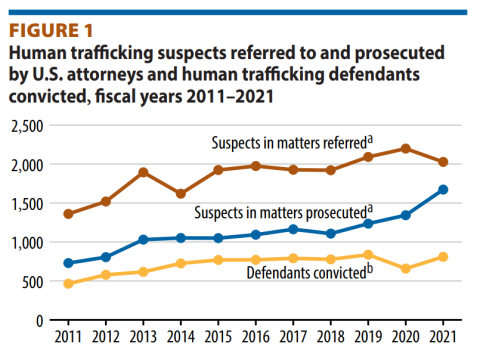Overview
What is human trafficking?
Human trafficking, also known as “trafficking in persons,” is a crime that involves the exploitation of a person for compelled sex or labor. They may be compelled via force, fraud, or coercion, which may be subtle or overt, physical or psychological. However, under federal law, force, fraud or coercion does not need to be present in a situation of sex trafficking of minors under the age of 18.
It is difficult to measure the magnitude of human trafficking in the United States. Victims and survivors of human trafficking are diverse in race, national origin, religion, age, gender, education level, and citizenship status. Human trafficking victims can be anyone.
The identity of traffickers is also varied. They can be foreign nationals or U.S. citizens. They can be family members, partners, acquaintances, or strangers to the victims.
January is Human Trafficking Prevention Month, an opportunity to educate the community about human trafficking and highlight the support services available to survivors.
How big a problem is human trafficking?
A report from the Bureau of Justice Statistics showed 2,027 persons were referred to U.S. attorneys for human trafficking offenses in fiscal year 2021, a 49% increase from the 1,360 persons referred in 2011.
In terms of prosecuting human trafficking cases in federal court, the number of persons prosecuted for human trafficking more than doubled from 2011 to 2021 (from 729 persons to 1,672 persons, respectively), according to the report.
While some statistics are available, they provide an incomplete picture of this complex issue. According to the Federal Bureau of Investigation, due to the nature of human trafficking, many of these crimes are never identified by local, state, Tribal, and federal law enforcement agencies that investigate them.
A study funded by the National Institute of Justice “found that inadequate victim identification was a problem not only for law enforcement but also for victim service providers.”
What is OJP doing to address human trafficking?
OJP is committed to building the capacity of communities and stakeholders to respond to human trafficking in trauma-informed, victim-centered, and evidence-informed ways. The Office for Victims of Crime (OVC) manages the largest amount of federal funding dedicated to the needs of human trafficking victims and multidisciplinary responses to human trafficking crimes. As of January 2023, this includes almost 500 awards totaling more than $320 million. This funding supports the following:
- services to victims
- as well as multidisciplinary teams
- statewide responses to child and youth trafficking
- training and technical assistance
Through its training and technical assistance (TTA) providers, OVC provides practitioner-driven, evidence-based support for victim services, multidisciplinary task forces and cross-sector collaboration. This support helps identify human trafficking victims and connect them to services.
The Building a Human Trafficking Program Resource Guide outlines the many resources available to provider organizations developing human trafficking programs.
In 2022, OVC released Child Victims and Witnesses Support Materials for use with young survivors of human trafficking. These materials help youth victims of trafficking between the ages of 12-18 learn how the justice system works, what their rights are, and more.
OVC also announced a partnership with the Office on Trafficking in Persons at the U.S. Department of Health and Human Services to develop standards of care for service providers supporting survivors of human trafficking and made an award to begin this important work.
The Office of Juvenile Justice and Delinquency Prevention (OJJDP) supports several programs to increase the availability of direct support services for children and youth who are victims of commercial sexual exploitation, facilitate outreach efforts, and develop organizations’ capacities to identify and respond to this vulnerable population.
Through the funding of rigorous research and evaluation, the National Institute of Justice (NIJ) supports the OJP’s human trafficking efforts with projects focused on:
- Strengthening the science of measuring the prevalence of human trafficking
- Preventing trafficking
- Improving the identification, investigation, and prosecution of traffickers
- Uncovering best practices for supporting services for victims
OJP strives to uphold the intent of the Trafficking Victims Protection Act of 2000 to ensure that all trafficking victims — regardless of immigration status, gender, or form of trafficking — receive the services they need to heal in the aftermath of victimization.
More on Human Trafficking from OJP
Visit the following pages for additional information and resources produced or sponsored by the Office of Justice Programs and other federal agencies:
| Justice System Response to Human Trafficking | Resources for Human Trafficking Victims and Service Providers | Additional Resources on Human Trafficking |








